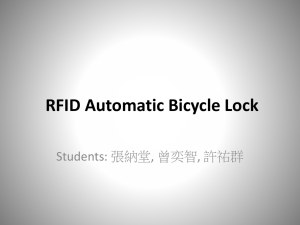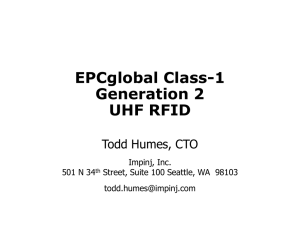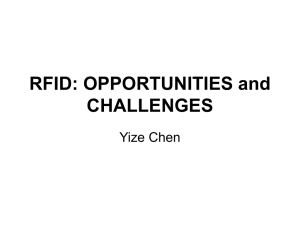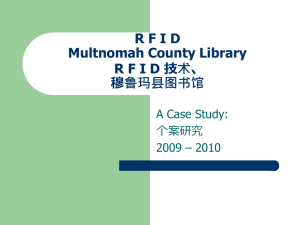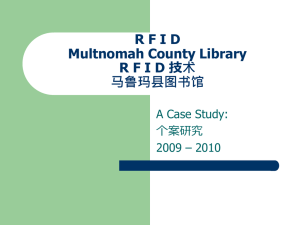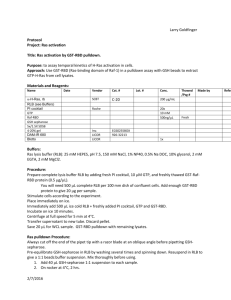Hybrid Method
advertisement
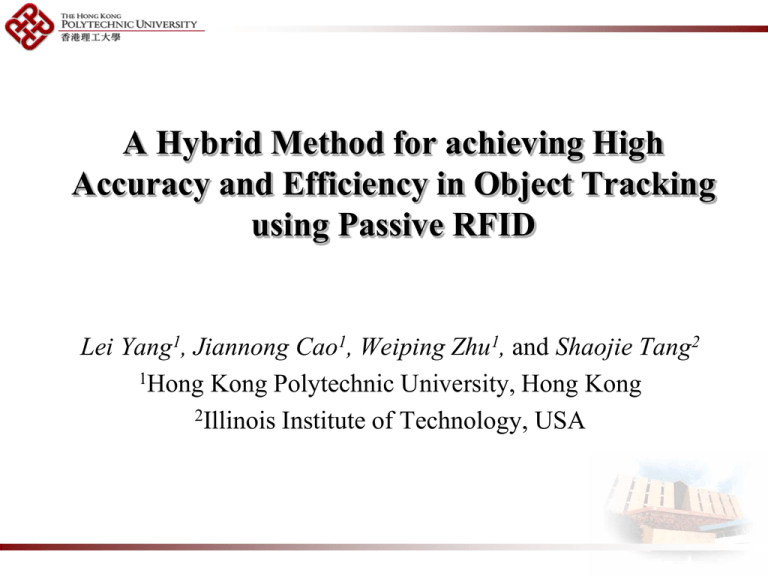
A Hybrid Method for achieving High
Accuracy and Efficiency in Object Tracking
using Passive RFID
Lei Yang1, Jiannong Cao1, Weiping Zhu1, and Shaojie Tang2
1Hong Kong Polytechnic University, Hong Kong
2Illinois Institute of Technology, USA
Outline
Introduction
Existing Approaches
Our Approach
Evalution
Conclusions
Motivation
Object tracking is desired by a lot of applications
Vehicles tracking in the warehouse managment
Wheelchair monitoring and tracking in the elderly
healthcare
Passive RFID is suitable in object tracking
Feasibility and low cost of large-scale deployment of
passive tags
Technical Difficulties
Real-time characterstic
Tracking is more difficult than localization of stationary
objects because executiion the algorithm needs to be
finished before a deadline
Noisy measurement
RFID reading is noisy, which means the tags have low
probability to be detected by the reader even though they
are within the object’s reading range
Constrained computional resource on the mobile
RFID devices
Problem Definition
v
Antenna
Given
H
K tags deployed in the enrionment
d
tr
Tags
The location of the i-th tag Ti
The RFID reader scans frequency f
The reader’s reading range is tr , which can be adjusted
The RFID reading at time k zk {rki }iK1
Assume
The reader has a probability p(r) to read the tags within its
reading range
r
Objective
, r tr
e
p(r )
0, r tr
Estimate the continuous locations of the mobile object using
the uncertain RFID readings
Existing Approaches
Centroid Localization (CL) [N.Bulusu 2000]
Average the locations of all the tags that have been detected by
the RFID reader
The tracking problem is solved by executing CL periodically
Low accuracy in case of low detecting probability
Weighted Centroid Localization (WCL)
Improve the accuracy by assigning weights in averaging the tags’
location
Each tag’s weight equals to the times that the tag has been
detected in past N scans
Large error if the object’s speed is large relative to the scanning
speed of the RFID reader
Both methods are computationally cheap
Estimated
Location
Estimated
Location
Existing Approaches
Centroid Localization (CL) [N.Bulusu 00]
Average the location of all the tags that have been detected by the
RFID reader
The tracking problem is solved by executing CL periodically
Low accuracy in case of low detecting probability
Weighted Centroid Localization (WCL) [Behnke08]
Improve the accuracy by assigning weights in averaging the tags’
location
Each tag’s weight equals to the times that the tag has been
detected in past N scans
Large error if the object’s speed is large relative to the scanning
speed of the RFID reader
Both methods are computationally cheap
• Count the detection times for each tag in recent 5 scans;
• The weight of each tags is equal to the count number.
t=1
t=2
t=3
t=4
t=5
Detection
times
Estimated
Location
1
4
2
1
3
2
v
• WCL has large error if the object’s speed is large relative to the
scanning speed of the RFID reader .
Existing Approaches
Centroid Localization (CL) [N.Bulusu 00]
Average the location of all the tags that have been detected by the
RFID reader
The tracking problem is solved by executing CL periodically
Low accuracy in case of low detecting probability
Weighted Centroid Localization (WCL) [Behnke08]
Improve the accuracy by assigning weights in averaging the tags’
location
Each tag’s weight equals to the times that the tag has been
detected in past N scans
Large error if the object’s speed is large relative to the scanning
speed of the RFID reader
Both methods are computationally cheap
Existing Approaches
Particle Filter [D.Hahnel06 ][Schneegans07] ][Vorst08]
The object’s location is calculated by averaging a set of
particles
Each particle represents a random location sample, and
has a weight in caculating the object’s location
In each iteration the particle evolves through three steps
Prediction - Predict the location of each particle according to
its location at previous time and the object’s moving speed
Updating - Update the weight of each particle according to the
sensory data
Resampling – Filter out the particles with small weight.
Existing Approaches
Particle Filter (PF)
The accuracy is better than CL/WCL, but continuous
execution of particle filter suffers from high computational
cost
PF achieves high accuracy by sacrificing the computational
efficiency
Our Approach
Observations
WCL are efficienct but the accuracy is not good when the
object’s speed is large
Particle filter has satisfactory accuracy but is costly
It is usual that the object moves with a varying speed
Can we integrate the two approaches together to
achieve better efficiency as well as accuracy?
Hybrid Method
Adaptively switch between using WCL and PF according to
the estimated velocity of the moving object
When the speed is low, WCL is used; otherwise, PF is used.
Our Approach
v
Antenna
Select the optimal reading range tr
H
d
Estimate the object’s speed v
v < vth
WCL
v > vth
Partical Filter
Tags
tr
Technical Details
Pratical Issues
How to determine the reading range (or power level) of the
reader?
How to estimate the speed of the moving object?
How to determine the threshold for the speed vth?
Technical Details
How to adjust the reading range tr (power level) ?
Density of tags is presented by its spacing a
The otpimal a/tr is 0.9
The necessary tr of the RFID reader should be as large as
1.1a
Technical Details
How to Estimate the object’s speed?
Calculate the time duration di(N) that each tag i stays in the
reader's reading range in the last N time slots (N di i)
Select the maximum one dmax(N) = max {di} to estimate the
speed
2tr c
v
d max ( N )
2tr is the diameter of the reading range; c is scaling constant
depending on the tag density ( 0<c<1 )
The tag with largest di tends to be the one which is closest
to the object's actual moving path
Technical Details
Consideration of the threshold vth
Threshold of the speed vth is too low, the hybrid method
has little improvement on the computational cost compared
with particle filter
If vth is set too high, the hybrid method sacrifices the
accuracy too much
2tr f
vth
Nth
We can control the tradeoff between accuracy and
efficiency by chosing proper Nth
Evaluation
Comparison between WCL and PF
Simulation environment’s size is 4m*4m
The object moves with constant speed along a rectangle
trajectory ( a = 0.27m, f=10Hz, tr = 0.3m )
v (m/s)
0.1
0.2
0.3
0.4
0.5
0.6
WCL (ms) 119
86
75
64
65
66
PF (ms)
8484
10568
9792
9260
9276
7593
Evaluation
How much does the Hybrid Method improve the
performance?
The object's velocity varies during the trajectory
Schemes
WCL
PF
Hybrid
Location
0.187
0.068
0.062
0.08
4.53
1.26
Error (m)
Execution
Times (s)
Evaluation
Indoor wheelchair tracking
RFID tags are densely deployed in a 4m*6m classroom.
The wheelchair moves along a line with a varying speed,
which is 0.1 m/s at the first half , 0.6m/s at the second half.
UHF RFID reader with a circularly polarized antenna
The reader has 8 power levels, we tune it on level 12.
tr = 60cm,
a = 50 cm,
f = 10Hz,
Nth = 40
Evaluation
Indoor wheelchair tracking
Experimental Results
The hybrid method almost achieve the same accuracy as
PF, but outperforms PF a lot in term of computational cost
Methods
WCL
PF
Location
Error (m)
Time per
step (ms)
0.482
0.186
Hybrid
Method
0.195
0.2
18.1
7.2
Conclusions
We proposed a hybrid method for achieving high
accuracy and efficiency in object tracking
The hybrid method is suitable for tracking the
mobile object which moves with a varying speed
Our method is demonstrated to be more
computational efficient than PF while guaranteing
the same accuracy with PF
Thank you!!
